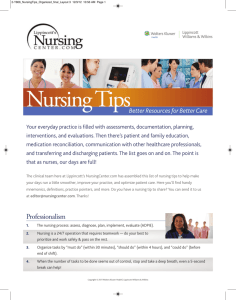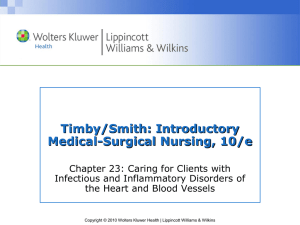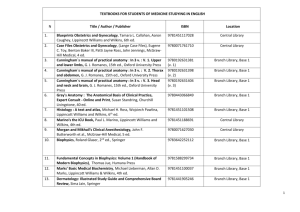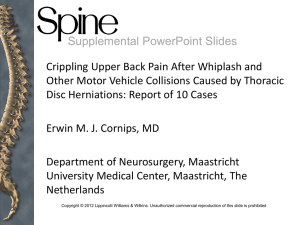PPT_Chapter_23_Physical Modalities
advertisement
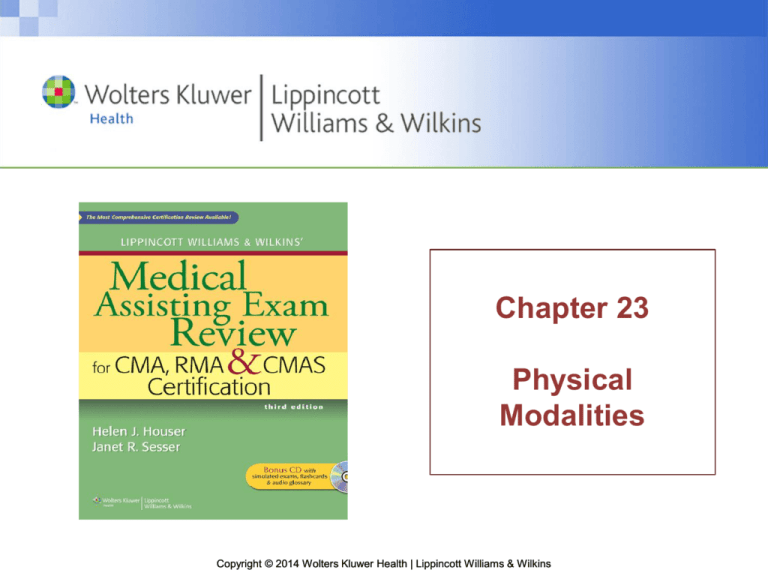
Chapter 23 Physical Modalities Copyright © 2014 Wolters Kluwer Health | Lippincott Williams & Wilkins Review Tip Your medical practice may not provide services for physical modalities or fitting of ambulation devices; however, it is important that the medical assistant recognize improper fitting and use when patients present with crutches, walkers, or canes. Information may be obtained from durable medical equipment vendors or retailers. Copyright © 2014 Wolters Kluwer Health | Lippincott Williams & Wilkins Overview Physical modalities are noninvasive therapeutic agents, procedures, and preventive measures used in the following: Physical medicine (physiatry)—diagnosis and treatment of disease and disability using physical means, such as diathermy ■ Rehabilitative medicine—restores and improves function impaired by disease or injury ■ Sports medicine—prevents and treats injuries and impairments that are sports related ■ Preventive health—applies techniques and uses devices to prevent injury and impairment (e.g., body mechanics) ■ Copyright © 2014 Wolters Kluwer Health | Lippincott Williams & Wilkins Mobility Testing ■ Goniometry—measurement of degrees of joint motion using a goniometer ■ Range of motion (ROM) test—exam requiring the patient to perform various joint motions to determine the extent of movement ■ Strength tests—exams requiring the patient to perform select muscle or muscle group actions to determine the strength of function ■ Activities of daily living (ADL) tests—exams that determine the patient’s ability to perform common tasks (e.g., opening doors, brushing hair) Copyright © 2014 Wolters Kluwer Health | Lippincott Williams & Wilkins Therapies Thermotherapy Thermotherapy uses heat to reduce swelling and to decrease pain by dilating blood vessels (vasodilation), increasing circulation to the affected area; it is not used in the initial phase of injury treatment: ■ Dry heat—heat without moisture • Heating pads—electrically or microwave-heated packs for thermotherapy use; should always be covered with fabric before placing on skin; check cords for safety and frequently monitor temperature to avoid burns • Chemical hot packs—heating pads filled with a chemical compound that produce heat when activated (usually by applying pressure); follow same precautions as for heating pads Copyright © 2014 Wolters Kluwer Health | Lippincott Williams & Wilkins Therapies, cont’d. • Infrared—heat produced by wavelengths in various lamp-like structures; position a safe distance from skin and monitor frequently to avoid burns • Ultraviolet—sunlamps used to treat specific conditions (e.g., psoriasis, newborn jaundice); patient’s eyes should be covered and length of exposure timed and monitored to avoid burns ■ Moist heat—heat with moisture sources • Hot soaks—water or water with antiseptic or other solution is warmed between 100ºF and 105ºF; affected area requiring treatment is submerged for a specific period • Hot compresses—fabric is wet with water or antiseptic or other solutions and placed on affected area; plastic-type wrap may be used to cover compress and conserve heat Copyright © 2014 Wolters Kluwer Health | Lippincott Williams & Wilkins Therapies, cont’d. ■ Paraffin—hand or foot is immersed in melted wax with additive such as mineral oil; plastic bags or “mittens” are worn after wax is applied to retain heat; when cool, the wax is peeled off; used for relief of arthritis pain ■ Diathermy—deep heat therapy using a mechanical energy source • Ultrasound—heat therapy using high-frequency sound waves; a special gel substance is placed on the head of the ultrasound attachment to improve conductivity • Microwave—heat therapy using electromagnetic radiation for tissues; should not be used with moisture or on patients with pacemakers Copyright © 2014 Wolters Kluwer Health | Lippincott Williams & Wilkins Therapies, cont’d. Cryotherapy Cryotherapy uses cold to prevent swelling and to reduce pain by causing blood vessels to constrict (vasoconstriction); it is used in the initial treatment of an injury: ■ Dry cold—cold therapy without moisture • Ice pack—waterproof bag filled with ice; air should be removed and bag covered with fabric before placing on skin; monitor to prevent skin damage • Chemical ice bag—pack filled with a chemical compound that produces cold when activated (usually by applying pressure); follow same precautions as with ice pack Copyright © 2014 Wolters Kluwer Health | Lippincott Williams & Wilkins Therapies, cont’d. ■ Moist cold—cold therapy using moisture • Cold soaks—water or water with antiseptic or other solution is cooled with ice and affected area is submerged for a given period • Cold compresses—fabric is wet with cold water or antiseptic or other solution and placed on affected area Copyright © 2014 Wolters Kluwer Health | Lippincott Williams & Wilkins Therapies, cont’d. Hydrotherapy Hydrotherapy uses hot- or cold-water regimens for therapy: Whirlpool—a bath or other container in which water is continually circulated to provide massage and heat therapy ■ Hot-to-cold plunges—the affected area is alternately plunged between hot and cold baths to contract and dilate vessels ■ Copyright © 2014 Wolters Kluwer Health | Lippincott Williams & Wilkins Therapies, cont’d. Exercise Exercise is an action to strengthen, develop, or maintain muscle: ■ Active exercise—an action to strengthen, develop, or maintain muscle that is performed directly by the patient • Isometric exercises—exercises that contract opposing muscles without the muscles shortening • Resistance exercise—exercises performed with counter pressure applied to increase the effectiveness and determine improvement • Water exercises—exercises performed in water Copyright © 2014 Wolters Kluwer Health | Lippincott Williams & Wilkins Therapies, cont’d. ■ Passive exercise—exercises performed on the patient by another person or by a mechanical device • Electrical stimulation—electrical device used to stimulate muscles or nerves • Passive motion device—a mechanical apparatus placed on a patient to passively exercise the affected area; frequently used on knees after surgery; speed and flexion may be increased or decreased according to the patient’s pain tolerance • Massage—rubbing, stroking, kneading, and tapping tissue with hands or devices to alleviate pain and improve function Copyright © 2014 Wolters Kluwer Health | Lippincott Williams & Wilkins Therapies, cont’d. Range of Motion Range of motion (ROM) can be passive or active; the patient or caregiver exercises joints by performing standard joint motions such as flexion and rotation to maintain or improve the extent of movement. Copyright © 2014 Wolters Kluwer Health | Lippincott Williams & Wilkins Therapies, cont’d. Other Common Physical Therapies Manipulation—maneuvers to realign affected area; frequently used on joint dislocations or spinal injuries ■ Immobilization—prevention of movement, usually of joint or bone, through the use of splints, casts, and other devices to reduce pain and allow healing to occur ■ Traction—application of a slow pulling force; commonly used to realign fractured bones ■ Copyright © 2014 Wolters Kluwer Health | Lippincott Williams & Wilkins Therapies, cont’d. Common Assist Devices ■ Cane—a rod-type device used for minimal standing or walking support as a reasult of weakness on one side or balance problems; the handle may be candy cane shaped or straight and perpendicular to the rod • Types—single-pronged, tripod, or four-pronged (quad); the length may be adjustable or nonadjustable • Fit—the patient’s elbow should be at a 30 angle when standing to obtain proper cane length • Gait—cane is held on patient’s strongest side, tip 4 inches to 6 inches lateral to the foot, tip flat on the ground; cane moves forward approximately 12 inches followed by the affected limb, which stops at the cane; the stronger limb moves forward to the cane, and steps are repeated Copyright © 2014 Wolters Kluwer Health | Lippincott Williams & Wilkins Therapies, cont’d. • Caution—stronger limb is first going up stairs, weaker limb first going down ■ Crutches—assistive walking devices, used singly or as a pair, which transfer weight bearing to upper extremities • Common types—standard or axillary crutches usually used for temporary conditions; Lofstrand or forearm crutches usually used for long-term disability • Fit—measure with the shoes patient will be wearing; patient standing; normally crutch tips are placed 4 inches to 6 inches lateral to each foot and 2 inches in front of feet; allow 2 to 3 finger widths between the axilla and the axillary support on crutches; adjust crutch height to accommodate; adjust handgrips to 30º of elbow flexion Copyright © 2014 Wolters Kluwer Health | Lippincott Williams & Wilkins Therapies, cont’d. • Common gaits—crutches placed on ground 4 inches to 6 inches lateral and 2 inches in front of feet - Swing-to gait—patient moves both crutches forward simultaneously, plants them, and lifts body to crutches; repeat steps - Swing-through gait—patient moves both crutches forward simultaneously, plants them, and lifts body past crutches; repeat steps - Two-point gait—the patient moves one crutch forward and the opposite foot at the same time, followed by the other crutch and other foot - Three-point gait (most commonly taught in medical office)— for weight bearing on one leg; patient moves both crutches and affected leg forward simultaneously and follows with unaffected leg; repeat steps Copyright © 2014 Wolters Kluwer Health | Lippincott Williams & Wilkins Therapies, cont’d. - Four-point gait—the patient moves right crutch forward, followed by the left crutch, and then the left leg forward parallel to the left crutch, followed by the right leg forward parallel to the right crutch; repeat steps • Caution—shoes should be flat and nonskid; avoid throw rugs, wet areas, and other hazards; to avoid axilla nerve damage, support weight using handgrips, not crutch underarm pads ■ Gait or transfer belt—a wide woven belt used to assist in lifting or steadying the patient during ambulation or transfer (e.g., car or wheelchair) • Placement—buckled over patient’s clothes around waist at midabdominal area; allow room for two fingers to fit between the waist and the belt • Caution—the belt should not be used if patient has no use of lower extremities; check for abdominal, back, or rib conditions and ostomy or feeding devices Copyright © 2014 Wolters Kluwer Health | Lippincott Williams & Wilkins Therapies, cont’d. ■ Walker—waist-high assistive walking device with four legs, used when a cane is not enough support; may be folded when not in use • Types—standard (fixed) with rubber-tipped legs; or can roll on wheels • Fit—client’s elbows flexed at 30ºangle; hand rests should be approximately at top of patient’s femur • Gait—patient steps into the walker and grasps handgrips, moves walker forward 6 inches to 12 inches then moves one foot at a time back into walker; repeat steps • Caution—walkers should not be used on stairs or narrow passages Copyright © 2014 Wolters Kluwer Health | Lippincott Williams & Wilkins Therapies, cont’d. ■ Wheelchair—a mobile chair with adjustable or nonadjustable footrests and brakes, used when a patient cannot ambulate • Types—nonmechanical or mechanical, standard size or custom fitted to patient • Caution—always lock brakes when patient is getting into or out of chair; do not allow patient to place arms around your neck Copyright © 2014 Wolters Kluwer Health | Lippincott Williams & Wilkins Body Mechanics Body mechanics is defined as the efficient use of the body to prevent injury to the health care provider or patient. The general guidelines follow: Keep the back straight ■ Keep abdominal muscles tight ■ Bend from knees, not back ■ Maintain a broad base with one foot slightly forward ■ Use the feet, not the body, to pivot ■ Carry heavy objects close to your body ■ Synchronize lifting, such as “on three—one, two, three” ■ Know your limits ■ Copyright © 2014 Wolters Kluwer Health | Lippincott Williams & Wilkins



